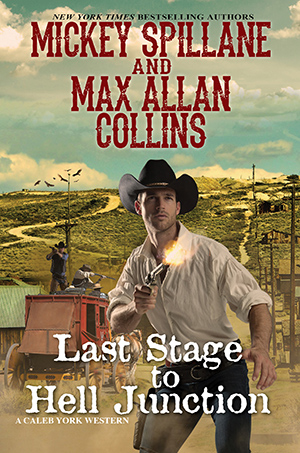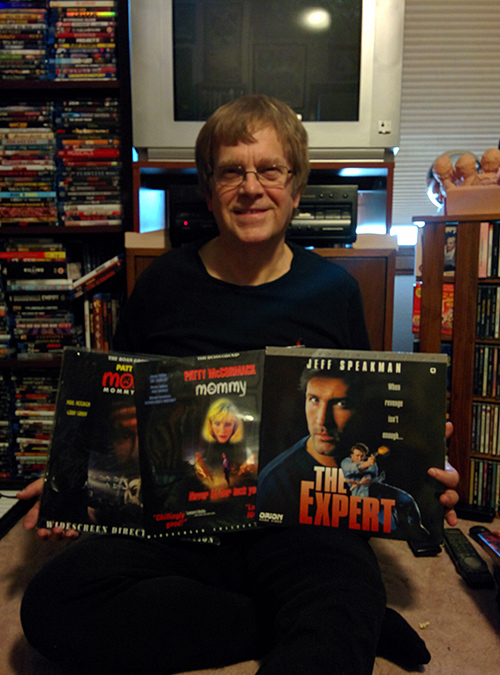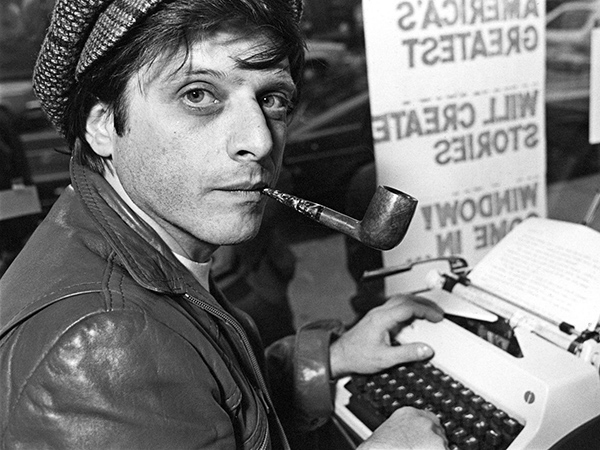Last week’s update was strictly pics from San Diego Con, and this time – along with some news and reviews – I will report in prose.
The highlight for me was the interview with my buddy Andrew Sumner, an exec at Titan; he and I did a Spillane two-man panel at SDCC last year and this time we focused on the upcoming release of the first of five Ms. Tree collections: One Mean Mother.
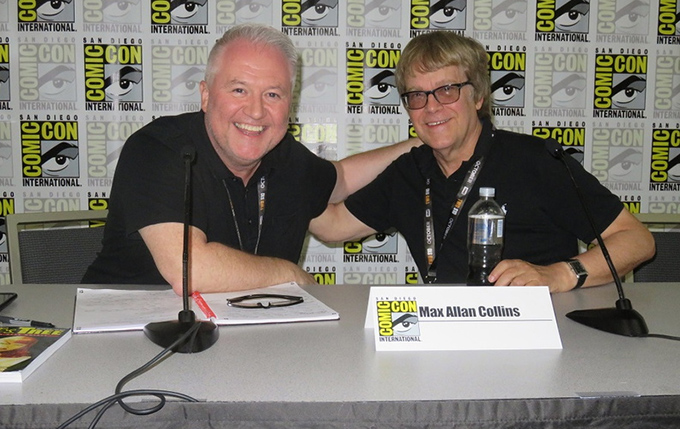
Andrew Sumner and M.A.C.
Jamie Coville posted the audio of our panel, a link to which you can find among the rest of his SDCC interviews – as of this writing, it’s the fourth entry down and you can download the audio by right-clicking the link once you navigate to this page.
A signing at the Titan booth – we had copies of Quarry’s War and the Mike Hammer graphic novel, plus free Ms. Tree art cards that I autographed – went very well. Got to talk to lots of smart fans – definition of “smart”: they like my work.
Jonathan Maberry did a great job, taking over for me as president of the International Association of Movie and Tie-in Writers, presenting the Scribe awards and helming a very good panel of mostly nominees. I did not win for Killing Town in the general fiction category, but did not expect to.
Otherwise, I have to admit that I find SDCC increasingly unpleasant and anything but user friendly. Part of this is my age, both in terms of physical tiredness and an absence of material of interest to me (Bud Plant, wherefore art thou?). Additionally, with this the 50th anniversary of the biggest con in pop culture, no particular fuss was in evidence. (The question I was most asked was, “Why isn’t Seduction of the Innocent playing?” And I have no answer.)
The aisles are hopelessly clogged, starting on preview night – in what I described to Barb as the world’s slowest moving stampede. Barb, doing an absent Nate’s bidding in search of inexplicably popular pins, had a series of increasingly harrowing, soul-destroying adventures in lines that were unfairly administered.
Here, in Barb’s words reporting back to Nate, are her experiences on Thursday, the official opening day of the con:
I went to the Figpin line at 1:30 to mill around for the public 2 o’clock queue-up but there was already a line of a dozen, so I hopped on board. Then the staff tried to disperse us saying it was too early to be there, and when ignored, brought security over. We scattered like cockroaches, only to come back when they left. I was amazed at the camaraderie when we re-formed, “No, I was behind him, you were in front of her,” etc. We were locked in a war together!
After a while, the enemy gave up, and we settled in for the real battle. But then distressing news began filtering down from the front, “They’re out of Batman and the Joker!” Recon was sent out to confirm. “Yes, and Hercule, too!” And so it went. After an hour and a half, battle fatigue set in, some went AWOL, but the rest of the troop pressed forward into the breach! And when the dust settled, I got Thanos, and the last Gogeta.
One funny story – when I was exiting the booth, this girl was telling a Figpin employee HER tale of woe, which was that she had gotten inside before the others this morning, in a motorized wheelchair, and was zipping toward where Figpin was handing out the “golden ticket cards,” when, about three yards from her goal, the chair died, and she was stuck in the aisle, watching helplessly as the cards all disappeared. The thing is, she was saying this while STANDING, and stomped off in a huff when no comp card was given.”
All this culminated on Sunday with a near riot that had Barb shoved up against some garbage cans. Seemed a Figpin staffer just started tossing the precious cards (required to make a purchase) into the air like chum to sharks. Figpin, perhaps the prime offender, will be lucky not to be sued. A company called Bait also rates a “boo,” as Nate put it.
This seems to me to be no fun, no matter what your age. Yes, it’s entertaining to see the cosplay – my favorite was Jason from Friday the 13th dragging a body behind him – but belligerent guards, rude people and impossible-to-get-into panels featuring your favorite stars add up to a popular culture nightmare.
It’s unlikely I’ll be back…but that was what I said last year.
My partner in Eliot Ness crime, A. Brad Schwartz, attended a different convention of sorts in Coudersport, PA’s annual Eliot Ness fest. Read about it (and see him!) here.
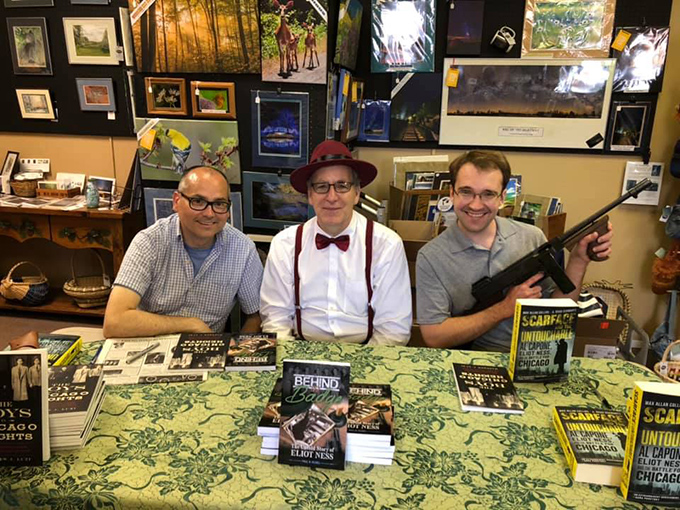
I completed my pass of the second Ness non-fiction book, The Untouchable and the Butcher, and just recently yesterday the third pass, which is primarily tweaking and catching typos and so on. Barb enters these for me, in most cases. This was a big job – the manuscript runs around 550 manuscript pages, and does not include Brad’s bibliographic end notes. I still have to assemble the chapter files into one big file of the whole book.
We did this in the midst of a major event – the move to Muscatine from the St. Louis area of Nathan, his wife Abby and our two grandchildren, Sam, almost four, Lucy, ten months. They will be living up the street just seven houses away, and it will be wonderful. Right now it isn’t – we are all struggling to maintain controlled chaos. More about this later.
A few TV notes.
Much on the streaming services has yet to capture my attention. But three series already very much on my radar have delivered excellent seasons that are worth your time, whether you munch on them or binge.
The fifth season of Schitt’s Creek continues to astound with its unique combination of deepening characterization and off-the-wall humor. Netflix has it, and if you’ve not watched this offspring of SCTV starring Catherine O’Hara and Eugene Levy (the latter’s son Daniel is a co-star and co-creator with his dad, and a genius), you need to drop everything and start. And it only gets better and better. For me, a particular pleasure is watching Chris Elliott bump his gonzo comedy style up against the Second City-trained cast members, creating a comic tension that provides the laughs with a special subtext.
Stranger Things has a third season that is broader than the first two but similarly satisfying. The central location, an ‘80s mall, provides a nostalgic backdrop that provided me with unexpected pangs – who knew I actually missed Sam Goody and B. Dalton? The storytelling is first-rate as the cast members are divided into groups for excellent back-and-forth narrative with tiny cliffhangers to hold you from scene to scene, and of course larger ones to keep you bingeing. Millie Bobby Brown continues to be a remarkable young actress, exploring this dangerously powerful girl’s entry into the teen years with poignance and possibilities. The creators, the Duffer brothers, have also found a way to avoid (this time anyway) the pitfalls of a character who can easily swoop in to save the day.
Finally, Veronica Mars roars in with an unexpected fourth season. I have not hidden my admiration for Kristen Bell (not even from my wife) and she outdoes herself here, bringing layers to her characterization with every pause and glance. This twisty mystery is hard to discuss without spoiler warnings, so I’ll say only that the season seems to be dealing with the need to move on from Neptune, California, and Veronica’s teenage years (the character is pointedly described as being in her late thirties) into adulthood and the maturity of a classic detective. Creator Rob Thomas clearly wants Veronica to join the ranks of Marlowe, Hammer, Nero & Archie, and other noir-ish detectives. I would caution him only that to abandon Enrico Colantoni’s Keith Mars, and the hilarious yet warm verbal interplay between father and daughter, would be to lose the heart and soul of the show. My favorite moment in the season has Veronica telling her father how irritated she is that her longtime lover Logan Echolls (Jason Dohring) has asked her to marry him. Keith’s droll low-key reply: “What an asshole.”
Check out this fantastic Leonard Maltin review of Scarface and the Untouchable.
Jude Law’s role is number six on this list of his best screen performances.
M.A.C.
